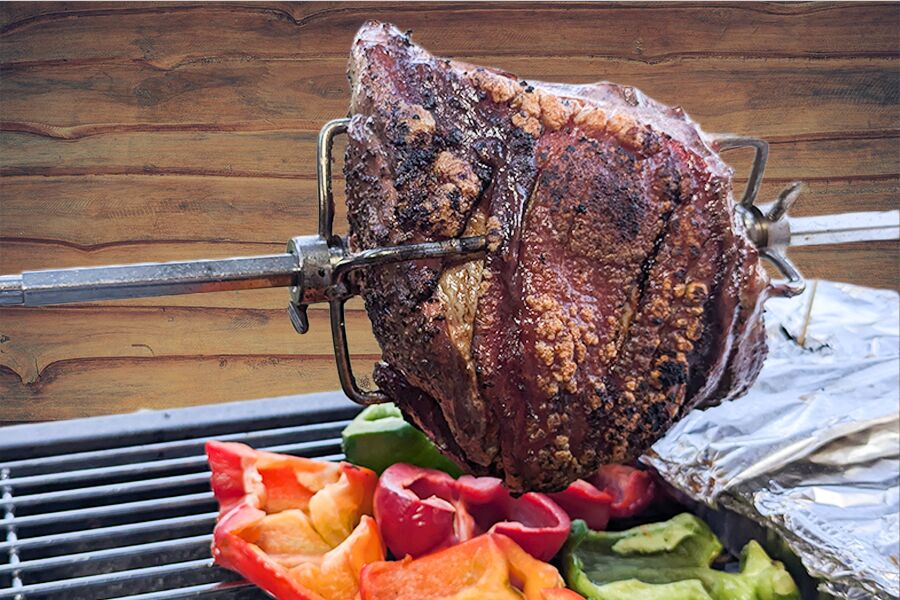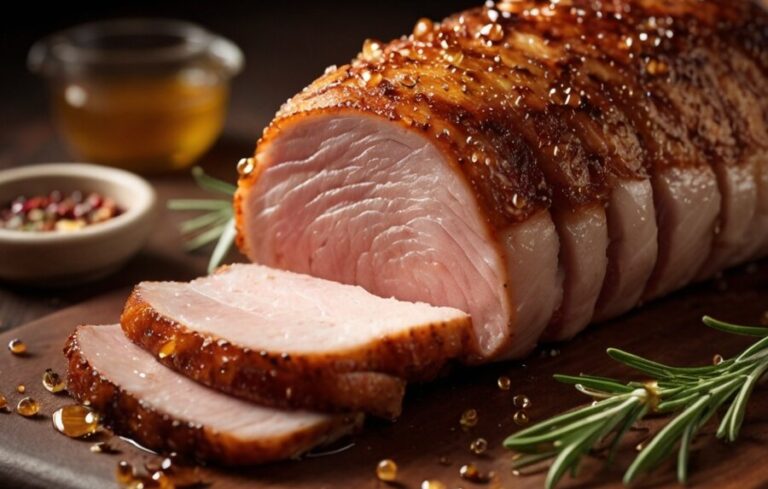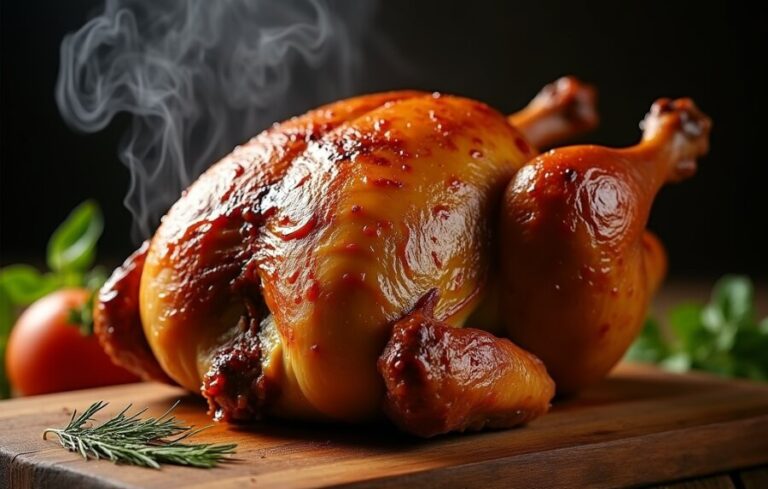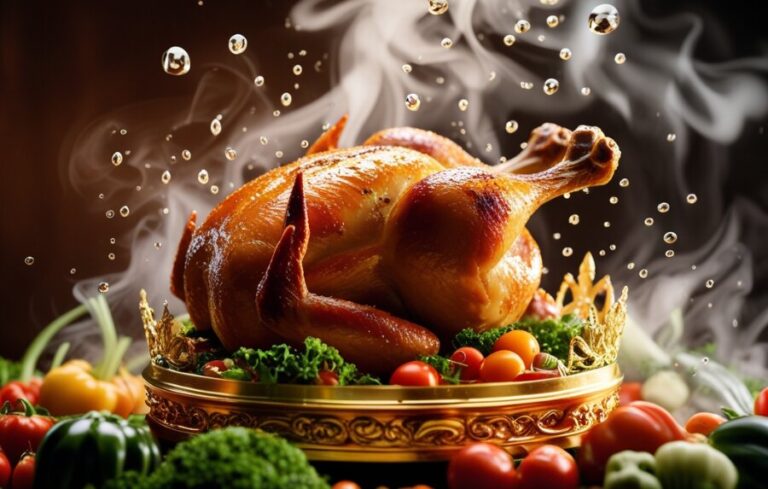Our evaluations and product assessments are conducted using a thorough and unbiased approach. Should you choose to buy any items through our provided links, we might receive a commission Read our disclosures.
Mastering Rotisserie Pork Shoulder
Rotisserie Cooking Basics
Let’s dive into the juicy world of rotisserie pork shoulder! This cut, also called “boston butt” or “blade shoulder,” is my top pick because it’s packed with flavor and stays moist even when well-done. Here’s how I get it right every time:
- Pick the Right Cut: Pork shoulder is loaded with marbling, which means flavor city.
- Prep the Meat: Trim off the extra fat, but keep some for that juicy goodness.
- Season Generously: Use a dry rub or marinade and let it soak in for a flavor explosion.
Cooking this beauty to perfection hinges on hitting the right temperatures. Here’s a quick guide:
| Temperature Stage | What Happens |
|---|---|
| 140°F | Safe but kinda tough |
| 150°F | Better, but not quite there |
| 180°F | Perfect! Connective tissues melt, turning the meat tender and juicy |
Nailing Juiciness and Tenderness
Rotisserie cooking is magic for pork shoulder, giving you a great texture — crispy outside, tender inside. Here’s what I do:
- Go Low and Slow: Cook it slow at a low temperature to melt down the connective tissue completely.
- Use a Meat Thermometer: No guesswork here. When it reads 180°F, you’re golden (Dad Cooks Dinner).
- Baste, Baby!: Keep it juicy by basting with its own juices or a tasty marinade.
Follow these steps and you’ll end up with a stunning dish that’s as fun to cook as it is to eat. Ready to try more? Check out some delicious rotisserie pork recipes and get cooking!
The Art of Rotisserie Cooking
Prepping Your Pork Shoulder
Alright, let’s get down to business. When I make a rotisserie pork shoulder, this specific cut is my go-to because of its unbeatable flavor and tenderness. Commonly called “boston butt” or “blade shoulder,” it’s the star because it’s got just the right amount of fat. That fat keeps the meat juicy, even when fully cooked. I always make sure to roast it until it hits at least 180°F. This works magic on the connective tissue, making the meat incredibly tender and delicious like it should be (Dad Cooks Dinner).
First things first, I like to score the fat cap on the pork shoulder. This not only looks kinda cool but helps the fat melt away during cooking, adding tons of flavor. After scoring, I rub it down with a mix of spices or marinade, letting it soak in the goodness for a few hours or overnight. Setting up your pork shoulder right is where the magic begins.
| Step | What to Do |
|---|---|
| 1. Pick Your Cut | Go for pork shoulder for that juicy, flavorful result |
| 2. Score the Fat | Helps melt the fat and adds flavor |
| 3. Rub or Marinade | Let it sit to absorb the flavors, ideally overnight |
| 4. Get Your Gear Ready | Make sure your rotisserie is set to cook the pork evenly |
Spicing Things Up
Now, this is where it gets fun. I love playing around with spices. My go-to dry rub usually includes paprika, garlic powder, and a bit of brown sugar. If I feel adventurous, I whip up a marinade with apple cider vinegar or mustard—these tenderize the meat and add a nice tang. The combination of a crispy outside and a tender inside makes rotisserie pork shoulder pure bliss.
For an extra kick of flavor, a wet brine can do wonders. It keeps the meat moist and packs in more taste. The final product can even have a bacon-like touch with that crispy crust and juicy interior (Dad Cooks Dinner).
Here’s a quick list of my favorite seasonings:
| Seasoning | Why I Love It |
|---|---|
| Paprika | Adds color and a bit of mild heat |
| Garlic Powder | Boosts savory flavor |
| Brown Sugar | Balances it out with sweetness |
| Apple Cider Vinegar | Tenderizes and adds some tang |
| Mustard | Gives a zesty punch |
Trying out different herbs and spices lets me tailor the flavors to my liking, and it makes every meal a flavor adventure. For even more ideas, I sometimes check out various rotisserie pork recipes that give me fresh ideas.
When you nail the prep and seasoning, your rotisserie pork shoulder will shine. Whether I’m throwing a barbecue with friends or hanging out solo, this dish never disappoints. Give it a whirl, and see for yourself how fantastic it can be.
Mastering the Rotisserie Process
Cooking on a rotisserie gives you that perfect blend of crispy skin and juicy meat. Here’s my tried-and-true method for nailing it every time.
Get Your Temps and Timings Right
Timing and temperature are your best buds when cooking a pork shoulder. The low-and-slow method is the secret sauce. Typically, I roast a pork shoulder for about four hours over charcoal at 225°F to 250°F. Here’s a quick guide to keep it simple:
| Cut of Pork | Temp (°F) | Time (hours) |
|---|---|---|
| Pork Shoulder | 225 – 250 | 4 – 6 |
| Pork Loin | 140 – 160 | 2 – 3 |
| Whole Pig | 210 – 250 | 6 – 12 |
Make sure your pork shoulder hits at least 180°F inside to break down all that connective tissue into melty goodness. Keep a meat thermometer nearby—you don’t want to eyeball this.
Tricks for Crispy Outside, Juicy Inside
Getting the right texture is part science, part magic. Here are my go-to tricks:
Brining: Soak your pork in a wet brine before cooking. It keeps the inside juicy. I stick to a basic brine mix.
Seasoning: Don’t be shy with seasoning. Rub it in generously with garlic powder, onion powder, salt, and pepper.
High Heat at the End: Towards the end, I like to turn up the grill to crisp up the outside. Watch it closely—burnt isn’t the same as crispy!
Resting Period: Let the pork rest for 15 to 20 minutes after you take it off the heat. It lets the juices redistribute, making every bite tender and moist.
These steps have never failed me in creating rotisserie pork shoulder that’s both tasty and impressive. If you’re looking for a deep dive on proper temps for different cuts, check out our rotisserie pork temperature guide. For more mouth-watering recipes, browse our collection of rotisserie pork dishes.
Happy cooking, and may your pork always be juicy and your skin always crispy!

Mastering Rotisserie Cooking
Reader Insights
I’ve gotten tons of great tips from fellow BBQ fanatics. These pearls of wisdom have fine-tuned my rotisserie pork shoulder game. One buddy’s family went wild over a rotisserie pork shoulder I suggested and thought I should try my hand at Cornish game hens or baby back ribs next. This shows that once you nail one recipe, a whole smorgasbord of flavors opens up.
Some folks have asked about tweaking the methods for leaner cuts, like picnic roasts. Remember, different cuts mean different cooking times and techniques, so keep your thermometer handy. For those who prefer grilling over coals instead of using a rotisserie, the trick is to manage your grill temperature properly. You’ll find essential tips on getting that perfect temperature right in my article on rotisserie pork temperature.
Tackling the Tough Stuff
Every recipe has its challenges, and rotisserie pork is no exception. I’ve had my share of pork shoulders that just didn’t want to become that melt-in-your-mouth delight. The key is to cook it nice and slow. The perfect combo of a crispy outside and tender, shreddable meat inside is what makes rotisserie pork shoulder irresistible. In one of my test runs, the flavor even reminded me of bacon.
Using a wet brine has been a game-changer for me—keeps that pork juicy and flavorful. Slathering on a maple syrup glaze as it’s nearly done can add an amazing touch.
Here’s a quick cheat sheet for common cooking tweaks:
| Problem | Fix | Tips |
|---|---|---|
| Pork not tender | Cook low and slow | Check temp until 195°F for that pull-apart goodness |
| Lean cuts like picnic roasts | Adjust time and temp | Less cooking time needed, keep an eye on it |
| Crispy skin desire | Bump the heat at the end | Finish with a blast of high heat for that crunch |
Cooking is all about experimenting. Every time you cook, you learn something new. Share your tips and we’ll do this dance together, achieving delicious rotisserie pork greatness! Want more yummy ideas? Check out my rotisserie pork recipes collection.
Mastering Rotisserie Pork Shoulder Flavors
If you’re like me and love to tinker with flavors when it comes to cooking, rotisserie pork shoulder offers a fantastic playground. From experimenting with different glazes to trying various cuts, the possibilities are endless. Here are two tasty variations I keep coming back to: the maple syrup glaze twist and exploring different cuts and glazes.
Maple Syrup Glaze Twist
One of my go-to favorites for jazzing up rotisserie pork shoulder is adding a maple syrup glaze near the end. Trust me, this makes a world of difference and adds a sweet twist that’s downright addictive. According to Dad Cooks Dinner, this can even make the pork taste like bacon. You heard that right—bacon.
Here’s how you do it:
| Step | Description |
|---|---|
| 1 | Wet Brine the Pork: Soak the pork shoulder in a wet brine to keep it moist. |
| 2 | Start Rotisserie Cooking: Cook the pork shoulder on the rotisserie as you normally would. |
| 3 | Add Glaze: Brush on the maple syrup glaze about 30 minutes before the pork is done. |
| 4 | Finish Cooking: Let the glaze caramelize as the pork finishes cooking to get that perfect sweet crust. |
Wanna get into more detail? Check out my article on rotisserie pork recipes.
Playing with Different Cuts and Glazes
The magic isn’t just in the pork shoulder; swapping out cuts can lead to tasty discoveries. I dabble with pork loin or even whole pigs for bigger gatherings. For more on these, dive into my posts on rotisserie pork loin and whole pig rotisserie.
And don’t even get me started on the glazes. Here are a few that I love:
| Glaze | Description |
|---|---|
| Honey Mustard | A mix of honey and mustard brings a delightful, tangy sweetness. |
| Barbecue Sauce | The classic—smoky, savory, and always a crowd-pleaser. |
| Teriyaki | A sweet and salty kick that pairs wonderfully with pork. |
Getting that tender, juicy perfection is all about keeping tabs on the rotisserie pork temperature. Every new combo I try just deepens my love for rotisserie cooking!
So fire up that rotisserie and start your own flavor experiments. There’s a whole world of taste waiting for you.
The Juicy Journey of Rotisserie
Where It All Began
The word “rotisserie” might sound fancy, but it simply comes from the French “rôtisserie” – which means “to roast” (Merriam-Webster). Back in the day, people cooked meat on spits over open flames, way before the first mechanical rotisseries showed up in Paris around 1450. Imagine the smoky goodness as folks manually turned the spit, ensuring every side of the meat got that perfect roast.
In those early times, outdoor fires were the norm. The resulting meals were not just tasty but genuinely unforgettable. It’s pretty awesome how this method has stood the test of time while staying true to its roots.
In kitchens, the rotisseur is the chef in charge of all things grilled and roasted (Wikipedia). Their job is no walk in the park – it’s an art. Ensuring the meat is roasted to perfection means the difference between an okay meal and a memorable feast.
Rotisserie in the Modern Age
Fast forward to today, and rotisserie cooking isn’t just for the pros anymore. Thanks to technology, we’ve got electric and gas-powered rotisserie grills that make it a breeze to get that perfect roast. Whether you’re a newbie or an experienced grill master, these modern gadgets have made it simpler and more precise to cook.
The beauty of modern rotisserie tools is that you can still achieve those delicious flavors and juicy textures with less hassle. It’s like having the best of both worlds – traditional taste with modern convenience.
Take a look at how old-school and new-school rotisserie stack up:
| Feature | Old-School Rotisserie | New-School Rotisserie |
|---|---|---|
| How It Works | Hand-turned | Mechanical or electric |
| Heat Source | Open fire | Gas, electric, or charcoal |
| Ease of Use | Needs skill and focus | User-friendly and adjustable |
| Flavor and Texture | Smoky, artisanal flavors | Consistent, versatile flavors |
The cool thing about today’s rotisserie techniques is the variety of meats you can cook, from rotisserie pork loin to whole pig rotisserie. With the right gear and know-how, nailing a perfect rotisserie pork shoulder is within reach. If your taste buds are tingling, check out our rotisserie pork recipes and pro tips for getting the rotisserie pork temperature just right for that mouth-watering goodness.
So, ready to turn up the heat on your next cookout? Let’s get roasting!








